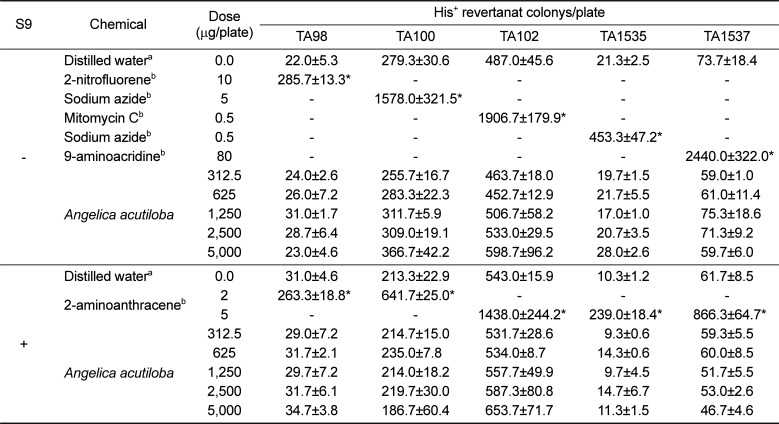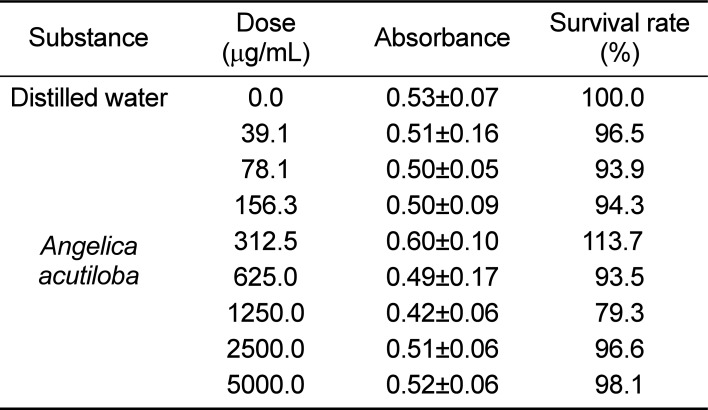1. Park MA, Sim MJ, Kim YC. Anti-Photoaging Effects of Angelica acutiloba Root Ethanol Extract in Human Dermal Fibroblasts. Toxicol Res. 2017; 33(2):125–134. PMID:
28503261.
2. Sheng YX, Li L, Wang Q, Guo HZ, Guo DA. Simultaneous determination of gallic acid, albiflorin, paeoniflorin, ferulic acid and benzoic acid in Si-Wu decoction by high-performance liquid chromatography DAD method. J Pharm Biomed Anal. 2005; 37(4):805–810. PMID:
15797805.

3. Wen KC, Huang CY, Lu FL. Determination of baicalin and puerarin in traditional Chinese medicinal preparations by high-performance liquid chromatography. J Chromatogr A. 1993; 631:241–250.

4. Liu IM, Tzeng TF, Liou SS, Chang CJ. Angelica acutiloba root attenuates insulin resistance induced by high-fructose diet in rats. Phytother Res. 2011; 25(9):1283–1293. PMID:
21308821.
5. Huntley AL, Ernst E. A systematic review of herbal medicinal products for the treatment of menopausal symptoms. Menopause. 2003; 10(5):465–476. PMID:
14501609.

6. Jeong SY, Kim HM, Lee KH, Kim KY, Huang DS, Kim JH, Seong RS. Quantitative analysis of marker compounds in Angelica gigas, Angelica sinensis, and Angelica acutiloba by HPLC/DAD. Chem Pharm Bull (Tokyo). 2015; 63(7):504–511. PMID:
25946978.
7. Yamada H, Komiyama K, Kiyohara H, Cyong JC, Hirakawa Y, Otsuka Y. Structural characterization and antitumor activity of a pectic polysaccharide from the roots of Angelica acutiloba. Planta Med. 1990; 56(2):182–186. PMID:
2353065.
8. Yoon TS, Cheon MS, Lee DY, Moon BC, Lee HW, Choo BK, Kim HK. Effects of root extracts from Angelica gigas and Angelica acutiloba on inflammatory mediators in mouse macrophages. J Korean Soc Appl Biol Chem. 2007; 50(4):264–269.
9. Tanaka S, Kano Y, Tabata M, Konoshima M. [Effects of “Toki” (Angelica acutiloba Kitagawa) extracts on writhing and capillary permeability in mice (analgesic and antiinflammatory effects)]. Yakugaku Zasshi. 1971; 91(10):1098–1104. PMID:
5170013.
10. Tanaka S, Ikeshiro Y, Tabata M, Konoshima M. Anti-nociceptive substances from the roots of Angelica acutiloba. Arzneimittelforschung. 1977; 27(11):2039–2045. PMID:
579998.
11. Lee K, Sohn Y, Lee MJ, Cho HS, Jang MH, Han NY, Shin KW, Kim SH, Cho IH, Bu Y, Jung HS. Effects of Angelica acutiloba on mast cell-mediated allergic reactions in vitro and in vivo. Immunopharmacol Immunotoxicol. 2012; 34(4):571–577. PMID:
22129085.
12. Kumazawa Y, Nakatsuru Y, Fujisawa H, Nishimura C, Mizunoe K, Otsuka Y, Nomoto K. Lymphocyte activation by a polysaccharide fraction separated from hot water extracts of Angelica acutiloba Kitagawa. J Pharmacobiodyn. 1985; 8(6):417–424. PMID:
3877157.

13. Kiyohara H, Yamada H, Cyong JC, Otsuka Y. Studies on polysaccharides from Angelica acutiloba. V. Molecular aggregation and anti-complementary activity of arabinogalactan from Angelica acutiloba. J Pharmacobiodyn. 1986; 9(4):339–346. PMID:
3735056.

14. Miyazawa M, Tsukamoto T, Anzai J, Ishikawa Y. Insecticidal effect of phthalides and furanocoumarins from Angelica acutiloba against Drosophila melanogaster. J Agric Food Chem. 2004; 52(14):4401–4405. PMID:
15237943.

15. Liu IM, Tzeng TF, Liou SS, Chang CJ. Regulation of obesity and lipid disorders by extracts from Angelica acutiloba root in high-fat diet-induced obese rats. Phytother Res. 2012; 26(2):223–230. PMID:
21647998.
16. Lee K, Sohn Y, Lee MJ, Cho HS, Jang MH, Han NY, Shin KW, Kim SH, Cho IH, Bu Y, Jung HS. Effects of Angelica acutiloba on mast cell-mediated allergic reactions in vitro and in vivo. Immunopharmacol Immunotoxicol. 2012; 34(4):571–577. PMID:
22129085.
17. Joo SS, Park D, Shin S, Jeon JH, Kim TK, Choi YJ, Lee SH, Kim JS, Park SK, Hwang BY, Lee DI, Kim YB. Anti-allergic effects and mechanisms of action of the ethanolic extract of Angelica gigas in dinitrofluorobenzene-induced inflammation models. Environ Toxicol Pharmacol. 2010; 30(2):127–133. PMID:
21787642.

18. Sarker SD, Nahar L. Natural medicine: the genus Angelica. Curr Med Chem. 2004; 11(11):1479–1500. PMID:
15180579.
19. Uto T, Tung NH, Taniyama R, Miyanowaki T, Morinaga O, Shoyama Y. Anti-inflammatory Activity of Constituents Isolated from Aerial Part of Angelica acutiloba Kitagawa. Phytother Res. 2015; 29(12):1956–1963. PMID:
26463105.

20. Markman M. Safety issues in using complementary and alternative medicine. J Clin Oncol. 2002; 20:39S–41S. PMID:
12235223.
21. Shin SH, Koo KH, Bae JS, Cha SB, Kang IS, Kang MS, Kim HS, Heo HS, Park MS, Gil GH, Lee JY, Kim KH, Li Y, Lee HK, Song SW, Choi HS, Kang BH, Kim JC. Single and 90-day repeated oral dose toxicity studies of fermented Rhus verniciflua stem bark extract in Sprague-Dawley rats. Food Chem Toxicol. 2013; 55:617–626. PMID:
23416650.

22. Che JH, Yun JW, Cho EY, Kim SH, Kim YS, Kim WH, Park JH, Son WC, Kim MK, Kang BC. Toxicologic assessment of Paecilomyces tenuipes in rats: renal toxicity and mutagenic potential. Regul Toxicol Pharmacol. 2014; 70(2):527–534. PMID:
25223566.

23. Che JH, Yun JW, Kim YS, Kim SH, You JR, Jang JJ, Kim HC, Kim HH, Kang BC. Genotoxicity and subchronic toxicity of Sophorae radix in rats: hepatotoxic and genotoxic potential. Regul Toxicol Pharmacol. 2015; 71(3):379–387. PMID:
25640205.

24. Yun JW, Kim SH, Kim YS, You JR, Kwon E, Jang JJ, Park IA, Kim HC, Kim HH, Che JH, Kang BC. Evaluation of subchronic (13week) toxicity and genotoxicity potential of vinegar-processed Genkwa Flos. Regul Toxicol Pharmacol. 2015; 72(2):386–393. PMID:
25882305.

25. Yun JW, Che JH, Kwon E, Kim YS, Kim SH, You JR, Kim WH, Kim HH, Kang BC. Safety evaluation of Angelica gigas: Genotoxicity and 13-weeks oral subchronic toxicity in rats. Regul Toxicol Pharmacol. 2015; 72(3):473–480. PMID:
26032491.

26. Ministry of Food and Drug Safety (MFDS). Good Laboratory Practice Regulation for Non-clinical Laboratory Studies (Notification No. 2014-67). Korea: MFDS;2014. Available [October 2014].
http://www.mfds.go.kr/.
27. OECD. OECD guideline for testing of chemicals, Test No. 471: Bacterial Reverse Mutation test. 1997.
28. OECD. OECD guideline for testing of chemicals, Test No. 473: in vitro mammalian chromosome aberration test. 1997.
29. OECD. OECD guideline for testing of chemicals, Test No. 474: mammalian erythrocyte micronucleus test. 1997.
30. Heddle JA, Stuart E, Salamone MF. Kilbey BJ, Legator M, Nichols W, Ramel C, editors. The bone marrow micronucleus test in Handbook of mutagenicity test procedures. Amsterdam: Elsevier;1984. p. 441–457.
31. Hakura A, Suzuki S, Satoh T. Advantage of the use of human liver S9 in the Ames test. Mutat Res. 1999; 438(1):29–36. PMID:
9858674.

32. Maron DM, Ames BN. Revised methods for the Salmonella mutagenicity test. Mutat Res. 1983; 113(3-4):173–215. PMID:
6341825.

33. Kaleeswaran S, Sriram P, Prabhu D, Mathuram LN. Chinnathambi. Anti- and pro-mutagenic effects of silymarin in the Ames bacterial reverse mutation assay. Phytother Res. 2009; 23(10):1378–1384. PMID:
19277970.

34. Fenech M, Morley AA. Measurement of micronuclei in lymphocytes. Mutat Res. 1985; 147(1-2):29–36. PMID:
3974610.

35. Perry P, Evans HJ. Cytological detection of mutagen-carcinogen exposure by sister chromatid exchange. Nature. 1975; 258(5531):121–125. PMID:
52847.

36. Tucker JD, Auletta A, Cimino MC, Dearfield KL, Jacobson-Kram D, Tice RR, Carrano AV. Sister-chromatid exchange: second report of the Gene-Tox Program. Mutat Res. 1993; 297(2):101–108. PMID:
7687323.

37. Luzhna L, Kathiria P, Kovalchuk O. Micronuclei in genotoxicity assessment: from genetics to epigenetics and beyond. Front Genet. 2013; 4:131. PMID:
23874352.

38. Akyıl D, Konuk M. Detection of genotoxicity and mutagenicity of chlorthiophos using micronucleus, chromosome aberration, sister chromatid exchange, and Ames tests. Environ Toxicol. 2015; 30(8):937–945. PMID:
24515492.










 PDF
PDF ePub
ePub Citation
Citation Print
Print


 XML Download
XML Download